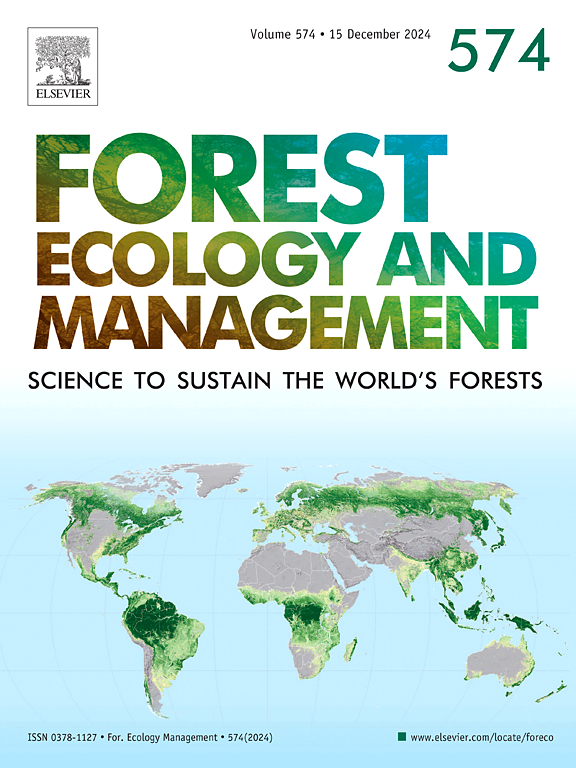Effects of experimental partial harvesting regimes on forest canopy structure and complexity
IF 3.7
2区 农林科学
Q1 FORESTRY
引用次数: 0
Abstract
The physical structure of forest canopies regulates numerous ecological processes and functions, and management strategies to promote specific structural features, such as high structural complexity, are increasingly desired. Partial disturbances — including partial harvests — can modify forest canopy structure, but their specific effects may be influenced by differences in characteristics such as intensity and frequency. Understanding the variable effects of silvicultural treatments on canopy structure will be essential to designing silvicultural regimes that can promote canopy structural complexity. We evaluated the effect of partial harvesting regimes on canopy structure (i.e., density, cover, height, arrangement, and heterogeneity) and complexity (as rugosity), quantified using a suite of metrics derived from portable canopy lidar, across three levels of harvesting intensity in three multi-decadal silvicultural experiments. We specifically assessed: 1) how repeated partial harvesting disturbance affected canopy structure and complexity relative to unmanipulated controls, 2) whether effects of partial harvesting differed among harvesting intensities or 3) between old- and second-growth stands, and 4) if canopy light interception differed among stands with different histories of partial harvesting disturbance. Findings indicated that canopy structure development under partial harvesting regimes differed from that of control stands, reducing vertical and canopy structural complexity at a fine (i.e., 1–6 ha treatment unit) scale, but increasing among-unit variability in canopy structure relative to controls. Variation in intensity among treatments produced relatively little distinction in fine-scale canopy structural outcomes, but the higher intensity selection harvesting regime in particular differed significantly from controls across all metrics of canopy structure. Partial harvesting affected the developmental trajectories of both old-growth and maturing, secondary forest stands, where selection-based management seemed to decrease structural features associated with old forests. Our findings suggest management regimes developed for timber goals could accommodate alternative goals that promote multi-scale canopy structural complexity across managed northern hardwood forest landscapes by adapting the timing (e.g., extending cutting intervals) and intensity (e.g., low intensity harvests) of partial harvesting to retain or develop elements of canopy complexity.
试验性部分采伐制度对林冠结构和复杂性的影响
林冠的物理结构调节着许多生态过程和功能,人们越来越希望采取管理策略来促进特定的结构特征,如高度的结构复杂性。部分干扰(包括部分采伐)可以改变林冠结构,但其具体效果可能受到强度和频率等特征差异的影响。了解造林处理对树冠结构的不同影响对于设计能促进树冠结构复杂性的造林制度至关重要。我们评估了部分采伐制度对树冠结构(即密度、覆盖度、高度、排列和异质性)和复杂性(即崎岖度)的影响,这些影响是通过便携式树冠激光雷达得出的一套指标量化的,在三个十年期造林实验中的三个采伐强度等级中均有体现。我们具体评估了1)相对于未受干预的对照组,重复部分采伐干扰如何影响树冠结构和复杂性;2)不同采伐强度或 3)老生林和次生林之间,部分采伐的影响是否不同;4)不同部分采伐干扰历史的林分,树冠截光是否不同。研究结果表明,部分采伐制度下的树冠结构发展与对照林分不同,在精细(即 1-6 公顷处理单元)尺度上降低了垂直和树冠结构的复杂性,但相对于对照林分,增加了树冠结构在单元间的变异性。不同处理之间的强度差异对精细尺度冠层结构结果的影响相对较小,但在冠层结构的所有指标方面,强度较高的选择性采伐机制与对照组的差异尤其显著。部分采伐影响了古老林分和成熟次生林分的发展轨迹,其中基于选择的管理似乎减少了与古老森林相关的结构特征。我们的研究结果表明,通过调整部分采伐的时间(如延长砍伐间隔)和强度(如低强度采伐)以保留或发展树冠复杂性要素,为木材目标而制定的管理制度可以适应促进多尺度树冠结构复杂性的北方阔叶林景观管理的替代目标。
本文章由计算机程序翻译,如有差异,请以英文原文为准。
求助全文
约1分钟内获得全文
求助全文
来源期刊

Forest Ecology and Management
农林科学-林学
CiteScore
7.50
自引率
10.80%
发文量
665
审稿时长
39 days
期刊介绍:
Forest Ecology and Management publishes scientific articles linking forest ecology with forest management, focusing on the application of biological, ecological and social knowledge to the management and conservation of plantations and natural forests. The scope of the journal includes all forest ecosystems of the world.
A peer-review process ensures the quality and international interest of the manuscripts accepted for publication. The journal encourages communication between scientists in disparate fields who share a common interest in ecology and forest management, bridging the gap between research workers and forest managers.
We encourage submission of papers that will have the strongest interest and value to the Journal''s international readership. Some key features of papers with strong interest include:
1. Clear connections between the ecology and management of forests;
2. Novel ideas or approaches to important challenges in forest ecology and management;
3. Studies that address a population of interest beyond the scale of single research sites, Three key points in the design of forest experiments, Forest Ecology and Management 255 (2008) 2022-2023);
4. Review Articles on timely, important topics. Authors are welcome to contact one of the editors to discuss the suitability of a potential review manuscript.
The Journal encourages proposals for special issues examining important areas of forest ecology and management. Potential guest editors should contact any of the Editors to begin discussions about topics, potential papers, and other details.
 求助内容:
求助内容: 应助结果提醒方式:
应助结果提醒方式:


